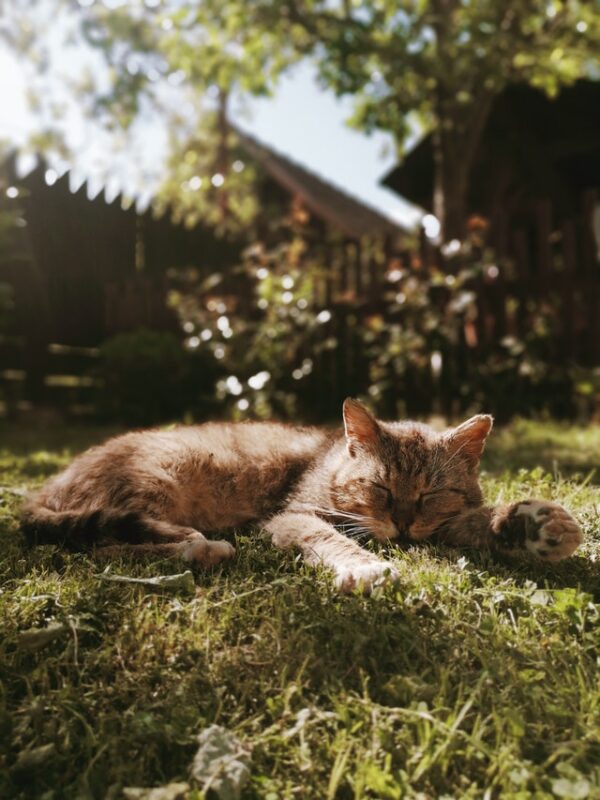Sun Safety Tips for Dogs and Cats
Posted: 07/28/2022 | BY: Jenna Bruce | Categories: Cat , Dog , Health problems , Top Tips
Summer is a wonderful time for you and the family to enjoy the great outdoors. But before you let your cat or dog spend hours lounging in the sun, read this article for some important sun safety tips!
Can Pets Get Sunburn?

You may think that only hairless pets, like the Mexican hairless dog or Sphynx cat, are at risk for getting a sunburn. But any animal can get sunburned in areas with little to no hair, including the tips of the ears, lips, noses and belly. If you often catch your dog lying in the sun on his back snoring, his little belly could become burned!
Some pets are more prone to sunburn, and those are the ones with thin coats or light-colored coats or those who suffer from hair loss as a result of a health condition such as allergies. Those pets who were recently shaved for a surgery are also more at risk of getting burned.
And before you think your indoor cats are 100% safe from sunburn, think again! Cats who regularly nap on windowsills can also become burnt. Unless you have had special windows installed, regular windows do not filter out harmful UV rays.
The Connection Between Sunburns and Skin Cancer in Pets

Just like people, our pets can get skin cancer called squamous cell carcinoma. And it is the areas of the skin that a repeatedly exposed to harmful UV rays of the sun that are far more prone to skin cancer. This is why it is so important to protect your fur baby from getting sunburned.
The good news is, early detection of anything irregular on your pet’s skin can make a huge difference in their prognosis. If you see any tiny lumps that look like warts, red spots or flakiness, this could be an indicator of cancer and you should bring your dog or cat in to the vet ASAP for proper diagnosis. When skin cancer is caught before it has a chance to spread to other parts of the body, it can often be eliminated through laser surgery or radiation.
How Can I Tell if My Dog or Cat is Sunburned?

Pets that have become sunburned will have the same symptoms as people who have sunburn. Their skin will appear red and maybe even dry and cracked. Their skin will also be painful, just as yours is when you get a nasty sunburn, so watch to see if they wince when you pet them. And finally, some pets with sunburn will constantly lick or bite at the affected area. And in the severest of sunburn cases, the dog or cat may have blistered skin and a fever.
If you see any of these signs, particularly those last two, it’s important to get your dog or cat in to see your vet pronto. In the case of blisters and open skin from your dog or cat chewing and licking, an infection can develop quickly.
Treating Sunburn in Pets
Minor cases of sunburn typically heal on their own, but should you see anything very red, painful or blistered, bring your cat or dog into the vet. They will perform a thorough exam to determine the severity of the burn, then recommend the appropriate treatment plan. Most treatments will involve shaving the affected area, then carefully cleaning the burn and applying topical ointment. You will most likely take this ointment home and apply it for a number of days. Your vet will then schedule a follow-up visit to make sure your baby’s skin is healing well.
Prevention

The number one way to prevent sunburn is to keep your fur baby out of the sun as much as possible, particularly that noonday sun, when it is at its highest and hottest. Now this doesn’t mean you and your four-legged pal can’t enjoy the outdoors together. You can as long as you take some precautions:
Sunscreen
Use a vet-approved sunscreen on those areas prone to burning like nose, ears and belly. Never use a human sunscreen as it may contain harmful ingredients that can irritate your pet’s skin or make them sick should they lick it off. Your vet should be able to recommend a good brand and also tips on applying it.
Switch Your Walking Time
Walk your dog(s) either in the early morning or late evening when the sun is not as intense. And also stick to those routes that offer the most shade.
Provide Shade in Your Backyard
If your backyard has a lot of shade trees, that’s great. But what if you have one of those rather sparse yards with little to no vegetation? Use patio umbrellas (stuck in the ground or in a planter), install awnings or pergolas to offer your pets some much-needed shade.
Install Solar Shades
If your dog or cat is getting most of their sun from laying near a glass door or window, you can install solar shades that block harmful UV rays.
Final Thoughts
The sun is a wonderful thing until you get too much of it! If you follow these tips you can keep your cat or dog safe from sunburn and in turn lower their risk of developing skin cancer.
Don’t Let High Vet Bills Burn You
If you’re like us, you love your fur babies so much you will do anything to ensure they live a long, happy and healthy life. But sometimes unexpected illness or injuries can occur, requiring vet care. And sometimes this vet care can be quite costly!
Pet Insurance Review was started by pet owners who wanted to help other pet owners who are struggling to pay high vet bills. We find the most comprehensive pet health insurance plans on the market today so you never have to worry. Did you know some plans can actually reimburse you for up to 90% of the vet bill?
Don’t let high vet bills stop you from providing the care your fur baby deserves. Get a free quote today.
References:
- Retrieved from Wikipedia: https://en.wikipedia.org/wiki/Sphynx_cat
- Bryce, E., (2018). Do Animals Ever Get Sunburned?” Fetched from: https://www.livescience.com/62677-do-animals-get-sunburned.html
- Howell JY, Ramsey ML. Squamous Cell Skin Cancer. 2022 Jan 21. In: StatPearls [Internet]. Treasure Island (FL): StatPearls Publishing; 2022 Jan–. PMID: 28722968. https://pubmed.ncbi.nlm.nih.gov/28722968/
- Ultraviolet (UV) Radiation and Sun Exposure. Retrieved from the EPA website: https://www.epa.gov/radtown/ultraviolet-uv-radiation-and-sun-exposure
Disclaimer
The information contained on this blog is intended for informational and educational purposes only and should not be construed as medical advice. It is not a substitute for professional veterinary care. Always consult with your veterinarian before making any changes to your pet's health care or treatment plan.
The authors of this blog are not veterinarians and do not claim to be experts in pet health. The information provided here is based on our own experiences and research, as well as information from reputable sources. However, we cannot guarantee the accuracy or completeness of this information.
We encourage you to do your own research and consult with your veterinarian before making any decisions about your pet's health.
Previous post
Does My Dog Have a Hernia?Next post
6 Tips to Keep Your Dog Cool this SummerCompare top pet insurance providers & plans.
Enter your dog’s age in years and months to calculate their age equivalent to human years.
Calculate your dog’s ageEnter your cat’s age in years and months to calculate their age equivalent to human years.
Calculate your cat’s age